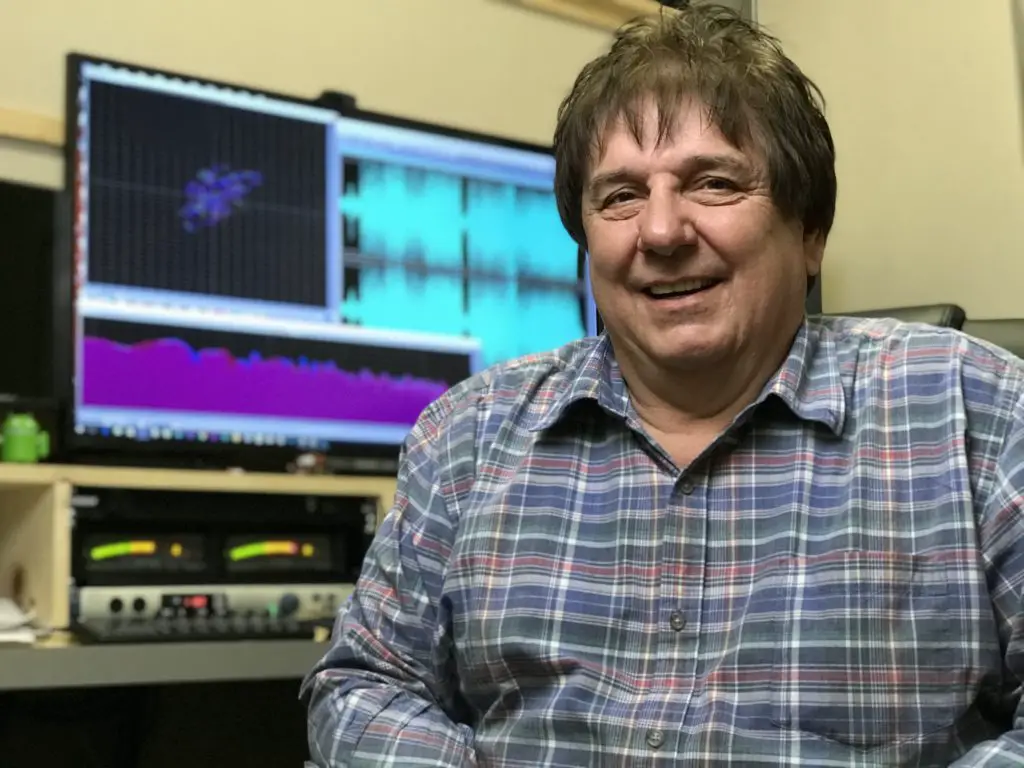
Magic! Audio Company Figures Out How to Restore Full Fidelity to MP3s
Buckle in. First I’m going to rant about bad digital audio. Then we’ll talk about how to fix it.
When development began on Motion Picture Expert Group, Layer 3–MP3 for short–at the Fraunhofer Institute in Germany in the late 80s, boffins were trying to figure out how to send digitized audio down plain old copper telephone wires. (POTs. Seriously.) But this medium wasn’t very good at carrying large amounts of digital information. The only hope of getting this to work was to find a way to compress these digital files down to a fraction of their original size.
Using the principles of psychoacoustics, researchers found a way to strip out all the material in a digital file that the ear couldn’t hear. Eventually, they were able to tune their algorithm so that a .wav file could be shrunk by 90% and still sound okay. By the middle 90s, Fraunhofer’s MP3s had become a worldwide standard, allowing music to freely zing about the Internet, bringing down the traditional music industry in the process.
Another advantage of MP3s was that they took up way less space than .wav files, a major consideration when well-equipped computers in 1999 had 200 MB hard drives. Smaller files also used less bandwidth at a time when most people were still using US Robotics dial-up modems. Who wanted to wait 90 minutes to download a single .wav file?

But be honest: MP3s may be convenient, but they sound like crap. Compared to the full-fidelity recordings from which they were ripped…well, there is no comparison. I know the engineers have equations that say we can’t tell the difference, but if you’ve ever done an A-B test between an MP3 and a CD (or better yet, a quality vinyl recording), the differences are obvious. Despite larger hard drives (256 gigs on your phone!), faster modems and cheaper bandwidth, we’re still treating music the same way we were 15 years ago.
Why? Habit, mainly. The other more insidious reason is that a generation or so only knows the fidelity presented by MP3s. They’re part of the “it’s-good-enough” crowd, people who are quite happy listening to music on crappy earbuds, through laptop speakers or–horrors!–through the speakers on their phones. Compared to people who grew up in the 70s and 80s–the cohort for whom loud, accurate stereo sound was everything–they have no idea how much they’re missing when they experience music this way.
The good news is that there seems to be a growing desire for better-sounding audio. At a panel on Hi-Res Audio at the All That Matters conference in Singapore last month, one expert said that new surveys indicate that 50% of people would be willing to pay more for digital music that sounded better. That number rose to 60% for those aged 25-34. Good. About bloody time.

This brings me to Bambu Tech, a California-company that’s come up with a way to restore compressed music files (MP3, AAC and so on–even FLAC) to CD quality sound and maybe even beyond.
I spoke to Lloyd Trammel, the co-inventor of the Advanced Wave Sound Method, aka AWSM (pronounced “awesome,” of course), which uses a form of AI known as “adaptive intelligence” that looks at a digital audio file, analyzes its harmonic structure, anticipates what needs to be fixed and then reconstructs things so that it sounds as good as the original source material. AWSM works at a sample-by-sample level. It doesn’t change everything as, say, EQ does. It works selectively. And it stays true to the original fidelity as it processes in nanoseconds.
Lloyd has a long career working with companies like Korg, Yamaha, Kawai, Roland and Peavey as well as contributing sound engineering and design to projects by artists such as Prince, Yes, Genesis, Led Zeppelin, and Emerson, Lake and Palmer. Some time ago, Lloyd and Bambu’s other co-founder, John Gould, began working on technology involving all sorts of different synthesis and wave-shaping techniques. “What we do is look at the waves coming in. Our system is smart so it needs to know what needs to be built up in all the harmonic structure. And it starts building the things immediately.”

In other words, the system can’t put the material back that was stripped away in the compression process, but it can interpret what’s missing, move ones and zeroes around to reconstruct the missing pieces or remove the garbage that compression leaves behind. So can the system listen to an MP3 and rebuild it? “Sure,” says Lloyd, “It can make it better than the CD you got with more resolution and dynamic range. It works with harmonic structures and additive synthesis, which is really boring if you’re not a big, big nerd. But if you take one of the harmonics out, you can still identify what the original was. We do it dynamically and in real time in ways that nobody’s thought about.”

He’s not joking, either. I’ve heard the demos and the results are nothing short of astounding. Truly, truly amazing. Get this: Because AWSM also preserves the harmonic integrity of a sound BEFORE it’s compressed, you can shrink a file down to a AM-radio bitrate (say, 32 kpbs) and still have something rather grand. (The people at ASWM are working on turning old, scratchy 78 RPM recordings from the 1920s into something more realistic and pure without the distortion inherent in the original recordings. But that’s another story for another time.)
Bambu is a business-to-business company. They’re talking to radio stations about improving the sounds of their online streams (Better sound and lower bandwidth costs! AM radio could be made to sound as good as FM!), streaming companies (Smaller files–up to 98% smaller–means storage savings!), movie theatres, and TV broadcasters (ASWM works with the audio portion of a video; Netflix would LOVE it). Potential customers are anyone who has anything to do with audio.
So what does this mean for the average person? Well, we could store even more songs on our phones, thanks to smaller and better sounding files. And no new hardware is required. If AWSM technology is put on at the beginning of the sound chain–encoded at the source–that’s all that’s required. No decoder is required on the consumer end. Or it works after decoding—in a device say. Unlike a codec, it doesn’t have to on both ends.
Because it can process audio before encoding OR after decoding, it means AWSM is backwards compatible. You don’t have to re-encode. You don’t have to buy new gear to realize better sound.
Too good to be true? Be as skeptical as you want, but if you heard these demos, you’d be a believer. Keep an eye out for Bambu. They could end up making music sound great again.

This post is brought to you by BAMBU.

“even FLAC”.
FLAC is lossless, there’s nothing to restore. If they claim to be improving that file its snake oil.
It can be argued that ANY audio converted to digital is compromised if only because it relegates a signal to ones and zeroes with nothing in between. But, as Musicman has so politely noted below, we can argue forever about the matter.
FLAC files are still large and, for now, adoption has been stunted by the practical cost considerations of bandwidth, and storage.
Fact of the matter is, unfortunately, the vast majority of audio already out there is “lossy.” Bambu improves it. It does so with just software. No re-encoding needed. No new hardware needed.
It works.
The issue here is that the blurb claims:
FLAC = CD quality, assuming a CD source. (And assuming the rip wasn’t flawed, but if it was, that’s a whole other can of worms.)
Throwing out an olive branch, I’ll concede it’s possible that it’s a nice DSP filter that makes music sound subjectively better to most people.
Here is a link to some current info about that:
https://lifehacker.com/5927052/whats-the-difference-between-all-these-audio-formats-and-which-one-should-i-use
FLAC is “compressed” , just not as much as other formats.
I didn’t say it wasn’t “compressed”, just that it is “losslessly” compressed, which means there is no missing information for this fancy technology to restore. FLAC has exactly the same fidelity as the source.
We could debate this one all day. It’s a matter of subjective taste. I have friends that will agree with me as you probably do too.
I’m not sure what part you think is subjective, but FLAC being loss-less is a fact. If you decompress it, you get the exact same audio out as you put in, unlike MP3. It’s like a zip file.
Is there going to be a software program available at some point, where we can do this at home?
Unfortunately, Bambu Tech’s AWSM is a B2B technology — targeted at the makers of audio devices, autos, and streaming services.
Unfortunately, Bambu Tech’s AWSM is a B2B technology — targeted at the makers of audio devices, autos, and streaming services.
Pingback: Links: Windowing is passé, piracy lawyers go to jail, MP3 “restoration,” Damo Suzuki. – Rocknerd